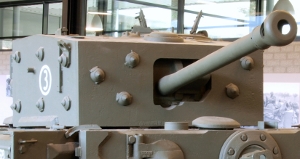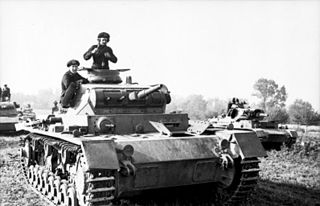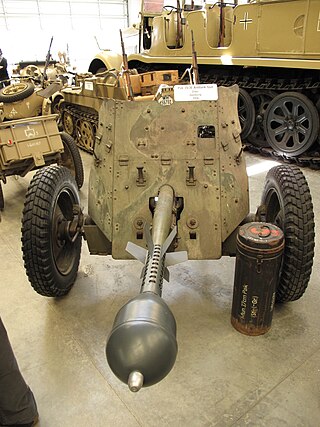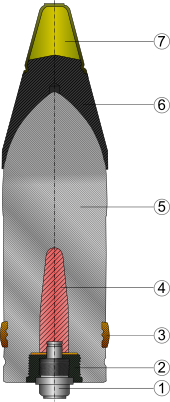
Armour-piercing ammunition (AP) is a type of projectile designed to penetrate armour protection, most often including naval armour, body armour, and vehicle armour.

The 8.8 cm KwK 36 was an 88-millimetre (3.5 in) tank gun used by the German Army during World War II. This was the primary armament of the PzKpfw VI Tiger I tank. It was developed and built by Krupp.

The 8.8 cm KwK 43 was an 88 mm 71-calibre-length tank gun designed by Krupp and used by the German Wehrmacht during the Second World War. It was mounted as the primary armament on the Panzerkampfwagen VI Ausf. B Tiger II. The 8.8 cm Pak 43, an anti-tank gun, was very similar in design but mounted on tank destroyers or deployed stand-alone on the field.

A shell, in a modern military context, is a projectile whose payload contains an explosive, incendiary, or other chemical filling. Originally it was called a bombshell, contrasting with solid shells used for early rifled artillery, but "shell" has come to be unambiguous in a military context. A shell can hold a tracer.

The Jagdpanzer 38, originally the Leichter Panzerjäger 38(t), known mostly post-war as Hetzer, was a German light tank destroyer of the Second World War based on a modified Czechoslovakian Panzer 38(t) chassis.

The Maschinengewehr (MG) 151 is a belt-fed autocannon for aircraft use, developed in Nazi Germany from 1934 to 1940 and produced by Waffenfabrik Mauser during World War II. It was originally produced in 15.1 mm caliber from 1940, with a 15×96mm cartridge, but due to demand for higher effect against aircraft, especially with the introduction of mine shells for the 20 mm MG-FF/M aircraft cannon, the design was rechambered to 20 mm caliber in 1941, using a newly developed 20×82mm cartridge which traded projectile velocity for explosive power. The initial 15 mm variant then became known as the MG 151/15, with the new 20 mm variant becoming the MG 151/20.

The 75 mm gun, models M2 to M6, was the standard American medium caliber gun fitted to mobile platforms during World War II. They were primarily mounted on tanks, such as the M3 Lee and M4 Sherman, but one variant was also used as an air-to-ground gun on the B-25 Mitchell medium bomber aircraft. There were five main variants used during the war: M2, M3, M4, M5 and M6.

The Ordnance QF 75 mm, abbreviated to OQF 75 mm, was a British tank gun of the Second World War. It was obtained by boring out the Ordnance QF 6-pounder 57 mm anti-tank gun to 75 mm, to give better performance against infantry targets similarly to the 75 mm M3 gun fitted to the American Sherman tank. The QF came from "quick-firing", referring to the use of ammunition where the shell has a fixed cartridge. The gun was also sometimes known as ROQF from Royal Ordnance Quick-Firing.

The 5 cm Pak 38 (L/60) was a German anti-tank gun of 50 mm calibre. It was developed in 1938 by Rheinmetall-Borsig AG as a successor to the 3.7 cm Pak 36, and was in turn followed by the 7.5 cm Pak 40. The unique curved gun-shield design differed from most WWII anti-tank guns which had either one flat or two angled and one flat gun-shield plates for ease of manufacturing.

The 7.5 cm Pak 40 was a German 75 millimetre anti-tank gun of the Second World War.

The 7.5 cm KwK 42 L/70 was a 7.5 cm calibre German tank gun used on German armoured fighting vehicles in the Second World War. The gun was the armament of the Panther medium tank and two variants of the Jagdpanzer IV self-propelled anti-tank gun. On the latter it was designated as the "7.5 cm Panzerabwehrkanone 42" anti-tank gun.
The Type 1 machine gun was a Japanese aircraft-mounted heavy machine gun widely used during World War II. It was also known as the Ho-103 in general use and as the Ho-104 when utilized in flexible mounts. The weapon itself was largely based on the American .50-caliber (12.7 mm) M2 Browning heavy machine gun, while the design of its ammunition was initially based on various Italian Breda-SAFAT 12.7 mm rounds. Japanese-designed and produced rounds eventually largely replaced these imported rounds.

The Ordnance QF 20 pounder was a British 84 mm (3.307 inch) tank gun. It was introduced in 1948 and used in the Centurion main battle tank, Charioteer medium tank, and Caernarvon Mark II heavy tank. After the 20 pounder gun was found to have inadequate performance against the Soviet T-54, the gun was mostly replaced in service by the larger calibre 105 mm L7 gun.

The Pak 43 was a German 8.8 cm anti-tank gun developed by Krupp in competition with the Rheinmetall 8.8 cm Flak 41 anti-aircraft gun and used during World War II. The Pak 43 was the most powerful anti-tank gun of the Wehrmacht to see service in significant numbers, also serving in modified form as the 8.8 cm KwK 43 main gun on the Tiger II tank, the open-top Nashorn and fully enclosed, casemate-hulled Elefant and Jagdpanther tank destroyers.

The 7.5 cm KwK 37 L/24(7.5 cm Kampfwagenkanone 37 L/24) was a short-barreled, howitzer-like German 75 mm tank gun used during World War II, primarily as the main armament of the early Panzer IV tank. Slightly modified as StuK 37, it was also mounted in early StuG III assault guns.

The 7.5 cm KwK 40 was a German 75 mm Second World War era vehicle-mounted gun, used as the primary armament of the German Panzer IV medium tank and the Sturmgeschütz III and Sturmgeschütz IV assault guns which were used as tank destroyers.

The 5 cm KwK 39 L/60(5 cm Kampfwagenkanone 39 L/60) was a German 50 mm calibre tank gun used during the Second World War, primarily as the main armament of later models of the German Panzer III tank from December 1941 onwards. It was produced when the well-armoured T-34 and KV-1 tanks were encountered in ever increasing numbers on the Eastern Front, although it was only partially successful in its role. It was later superseded by the 7.5 cm KwK 40 L/43.

The 3.7 cm KwK 36 L/45(3.7 cm Kampfwagenkanone 36 L/45) was a German 3.7 cm cannon used primarily as the main armament of earlier variants of the German Sd.Kfz. 141 Panzerkampfwagen III medium tank. It was used during the Second World War.

7.5 cm Pak 39 (L/48)(7.5 cm Panzerjägerkanone 39) was a 7.5 cm German Second World War era anti-tank gun. The gun was used to equip Jagdpanzer IV/48 and Jagdpanzer 38 tank destroyers; no towed version of the weapon was made. The Pak 39 was an electrically fired weapon fitted with a semi-automatic breech mechanism and a 48 caliber long barrel. The gun was able to destroy the most common allied tanks at up to 1,000 meters. It used the same 75 x 495R ammunition as the 7.5 cm KwK 40 of Panzer IV and 7.5 cm StuK 40 gun fitted on the Sturmgeschütz assault guns. The Pak 39 was manufactured from 1943 onwards by Rheinmetall-Borsig AG in Unterlüß and by Seitz-Werke GmbH in Bad Kreuznach. The main types of ammunition used were: Panzergranatpatrone 39 (APCBC), Sprenggranatpatrone 37 (HE) and different versions of the Granatpatrone 39 HL (HEAT).

The Stielgranate 41 was a German shaped charge, fin-stabilized shell, used with the 3.7 cm Pak 36 anti-tank gun to give it better anti-tank performance.



















